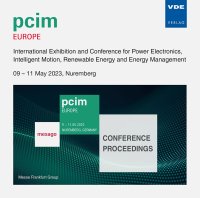Thermal Management of a Compact High Power Factor Air Cooled Isolated 12kW 9 Litre SiC Three-Phase AC/DC Converter
Conference: PCIM Europe 2023 - International Exhibition and Conference for Power Electronics, Intelligent Motion, Renewable Energy and Energy Management
05/09/2023 - 05/11/2023 at Nürnberg, Germany
doi:10.30420/566091158
Proceedings: PCIM Europe 2023
Pages: 7Language: englishTyp: PDF
Authors:
da Cunha, Jean C.; Vykukal, Radko; de Sousa, Luis (Traco Power Solutions, Ireland)
Abstract:
The rapid change in the energy landscape driven by geopolitical factors pushes for transition towards renewable energy and increased mobility electrification, leading to a surge in energy demand. Therefore, power quality and efficiency will become vital in automotive industries (eg. off-board chargers), optimizing the use of transmission lines and power sources. Compactness is also in high demand as space is often a constraint in industry. Energy converters can achieve such demands by having a close to unity power factor and by optimizing their thermal management concepts, their efficiency and mechanical structures. This paper presents and focuses on the thermal management concept of key power components of a 12kW three phase three wire AD-DC converter which also has high power factor and an isolation stage. A compact design was made for industrial applications, pushing the boundaries of Air-cooled AC-DC Converters’ power density to one the of highest levels in industry today. Power density levels of 1.8kW/L was achieved on the main power stage. Furthermore, the paper compares the power density levels of the current converter to industry state-of-the-art standards.The converter topology and thermal management approach are presented in detail, along with a description of the thermal model used to calculate estimated temperatures. The paper also presents experimental measurements of power component temperatures at 12kW load and 50deg C room temperature, demonstrating unit power factor and low harmonic content. Comparisons between the estimated and experimental thermal results are made, confirming the validity of the thermal modeling methods and the success of the thermal management strategy.


